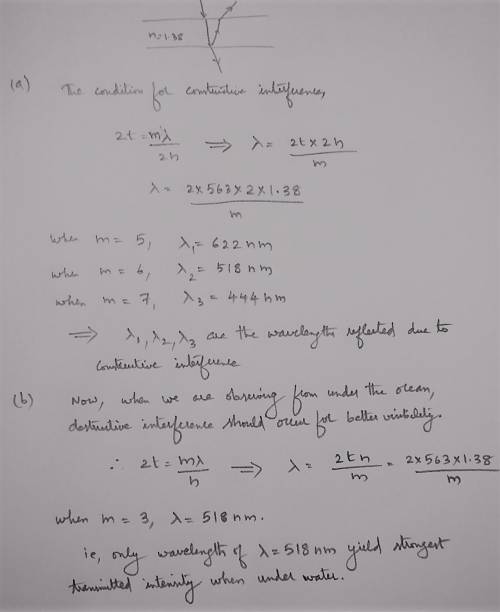
Physics, 21.04.2020 23:50 silverdays1215
A thin layer of oil (n = 1.38) on the ocean surface for thousands of miles. As an inspector, you are flying over the ocean surface in an aircraft, looking at a section of option where the oil thickness is 563 nanometers thick. You look straight down at the ocean, at a time of day when the sun is directly above you. a) So, if constructive interference occurs (i. e. where the reflection is brightest) what is the wavelength(s) of visible light in the reflection? b) However, in order to get a close-up look at the oil slick, you put on scuba gear and go diving under the portion of ocean you had been observing from the plane. For which wavelength(s) of visible light yield the strongest transmitted intensity?

Answers: 1


Other questions on the subject: Physics

Physics, 22.06.2019 14:20, kaylaelaine18
What are the starting materials for nuclear fission? two small nuclei two large nuclei a neutron and a large nucleus a neutron and a small nucleus
Answers: 2


Physics, 23.06.2019 02:40, HannaTheGurls
If a rock is thrown upward on the planet mars with a velocity of 10 mys, its height in meters t seconds later is given by y − 10t 2 1.86t 2 . (a) find the average velocity over the given time intervals: (i) [1, 2] (ii) [1, 1.5] (iii) [1, 1.1] (iv) [1, 1.01] (v) [1, 1.001] (b) estimate the instantaneous velocity when t − 1.
Answers: 2
You know the right answer?
A thin layer of oil (n = 1.38) on the ocean surface for thousands of miles. As an inspector, you are...
Questions in other subjects:






Biology, 31.01.2020 01:54

Mathematics, 31.01.2020 01:54



Mathematics, 31.01.2020 01:54




